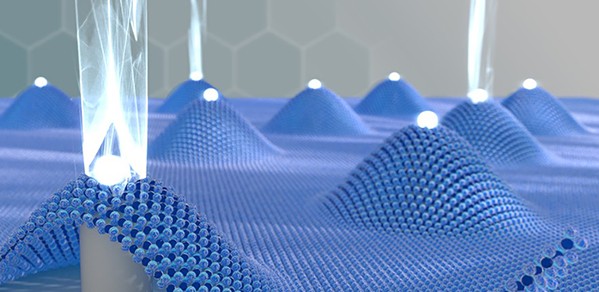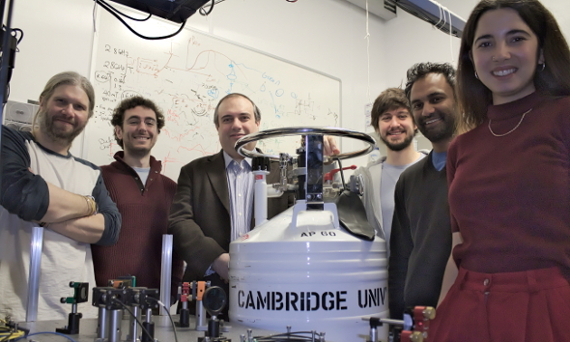
Large scale, fully integrable arrays of single photon quantum emitters are demonstrated in layered materials, which could lead to hybrid on-chip photonics devices for networks and sensing.
Quantum technologies are key investment areas for Europe, with a new Quantum Flagship recently announced. Layered materials could be enablers of a future integrated technology.
Professor Andrea Ferrari, Director of the Cambridge Graphene Centre
Transition metal dichalcogenides (TMDs) are layered semiconductors that can be exfoliated into layers only a few atoms thick. Recent research has shown that some TMDs can contain quantum light sources that can emit single photons of light. Until now, the occurrence of these quantum light emitters has been random, so they were not suitable for large scale applications.
Now, researchers working at the University of Cambridge, UK, supported by the Graphene Flagship, have created large scale arrays of these quantum emitters in different TMD materials. The work, also involving researchers from Harvard University, US, is published in Nature Communications. This new approach leads to large quantities of on-demand, single photon emitters, paving the way for integrating ultra-thin, single photons in electronic devices.
Single photons on demand
Quantum light emitters, or quantum dots, are of interest for many different applications, including quantum communication and networks. Until now, it has been very difficult to produce large arrays of quantum emitters close together while keeping the high quality of the quantum light sources.
“It’s almost a Goldilocks problem – it seems like one either obtains good single photon sources, or good arrays but not both at the same time. Now, all of a sudden, we can have hundreds of these emitters in one sample,” said Professor Mete Atatüre, a professor at the Cavendish Laboratory of the University of Cambridge and a fellow of St John’s College.
Previous research into quantum emitters in TMDs relied on random occurrences, making systematic production and investigation difficult.
“The ability to deterministically create our sources has made a dramatic change in the way we do our day-to-day research. Previously it was pure luck, and we had to keep our spirits high even if we didn’t succeed. Now, we can do research in a more systematic way,” said Professor Atatüre. Not only does this new method make performing research more straightforward, but it also leads to improvements in the emitters themselves: “The quality of the emitters that we create on purpose seems to be better than the natural quantum dots.”
The ability to create deterministic arrays gives a new opportunity to study the TMD quantum emitters in more detail.
Dr Dhiren Kara, a researcher at the Cavendish Laboratory, said “There is lots of mystery surrounding these emitters, in how they originate and how they work. Now, one can directly create the emitters and not have to worry about waiting for them to appear randomly. In that sense, it speeds up a lot of the science.”
Importantly, arrays of quantum emitters were demonstrated in different types of TMD, tungsten diselenide and tungsten disulphide. These materials emit at different wavelengths, which is important for development of future technologies where different types of light are needed. Another avenue the researchers are keen to explore next is the possibility of generating polarised light as stationary qubits for quantum networks, as well as their potential use in optical sensing devices.

The research team at the University of Cambridge. L-R: Mete Atatüre, Alejandro R.-P. Montblanch, Andrea Ferrari, Matteo Barbone, Dhiren Kara, Carmen Palacios-Berraquero. Credit: Pawel Latawiec/Harvard University.
Nanopillars of light
To create the quantum light sources, the researchers cut an array of nanoscale pillars into silica or nanodiamond, and then suspended the few-atom-thick TMD layer on top of the pillars. The quantum emitters are then created in the TMD where it is supported by the pillars, so it is possible to choose exactly where the single photons should be generated.
“The fact that the emitters are generated in a mechanical way is good, because it means that they are quite robust, and material independent,” said Carmen Palacios-Berraquero, a researcher at the Cavendish Laboratory and first author of the work.
This research is a great step forward to creating on-chip single photon sources. With this deterministic and robust generation of quantum sources, there are new opportunities for hybrid structures of photonic and electronic functions layered together in a single device, and the method is fully scalable and compatible with silicon chip fabrication.
“Layered semiconducting materials have distinct unique properties and this realisation of deterministic generation of quantum dots is a real paradigm shift as this has so far been impossible with other materials,” said Professor Frank Koppens, of ICFO, Spain, the Leader of the Graphene Flagship Optoelectronics Work Package.
Professor Andrea Ferrari, Director of the Cambridge Graphene Centre, and Science and Technology Officer and Chair of the Management Panel of the Graphene Flagship, was also involved in the research. He added "Quantum technologies are recognised as key investment areas for Europe, with a new Quantum Flagship recently announced. It is great to see that layered materials have now a firm place among the promising approaches for generation and manipulation of quantum light and could be enablers of a future integrated technology."

